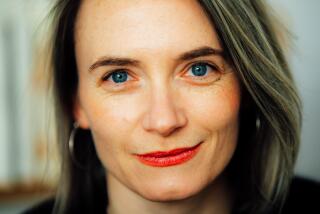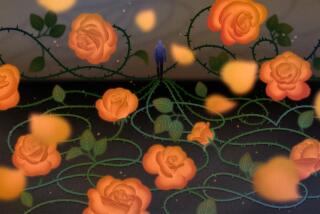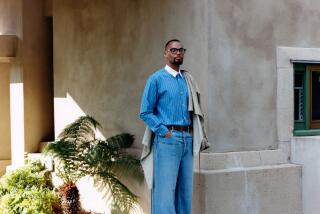The Quest for a New Age : HEAVEN ON EARTH: Dispatches From America’s Spiritual Frontier <i> By Michael D’Antonio</i> , <i> (Crown: $20; 422 pp.) </i>
In “Heaven on Earth,” Pulitzer Prize-winning reporter Michael D’Antonio shows us both the strengths and limitations of a journalistic approach to the New Age movement. In some instances, he has confused frontiers and fringes. He also is occasionally inaccurate. Hollywood, for example, is not the New-Age center of Southern California.
And yet D’Antonio brings superb writing talents to bear on extravagant adventures: visits to Maharishi International University in Fairfield, Iowa; faith healer Louise Hay and her AIDS patients in Los Angeles; Lazaris (a “channeled entity”) in Philadelphia, and UFO-watchers in Sedona, Ariz.
He played “mystic baseball” at the Omega Institute, listened to physician Bernie Siegel at the Whole Earth Expo in New York, attended a one-day seminar in Detroit led by psychiatrist Scott Peck and discussed business with Ben and Jerry, Vermont’s progressive “ice-cream capitalists.” He took part in an “Earth tribe” ritual in a Sierra Nevada forest, venturing deep into the Sequoias and chanting “Earth my body / Water my blood / Wind my breath / And fire my spirit.”
Occasionally D’Antonio’s cool and ironic reportorial pose distances us from the subject. Yet from the outset, D’Antonio performs a service by defining the significance of this movement.
Many writers and social critics have dismissed the New Age, “but such a negative assessment,” D’Antonio points out, “ignores the ways that the movement has come to influence mainstream culture.” Sociologists at UC Santa Barbara, he reports, estimate that as many as 12 million Americans could be considered active participants, and another 30 million are avidly interested. If all of these people were brought together in a church-like organization, it would be the third-largest religious denomination in America.
Most participants adopt ideas about health, politics, psychology or spirituality without identifying the movement as broadest sense, is an attempt to discover ideas and practices that might be added to mainstream culture in order to make modern life richer and more satisfying.”
An article in American Demographics defines New Agers as a well-educated, upscale group. More than 90% of the subscribers to NewAge magazine are college graduates, compared to less than half the general population. They are three times likelier than others to travel abroad and four times more likely to be active in politics or community affairs. The demographers conclude that these individuals “are hungry for something mainstream society has not given them.”
The movement arose in part, D’Antonio proposes, because “those who leave the structure of mainstream religion nonetheless retain the basic human need for community, ritual and spiritual expression. New Agers have not stopped considering the spiritual questions that, as psychiatrist Robert Coles has shown, first visit us in childhood.” The rampant materialism of the ‘80s, along with moral and economic upheaval, left us in uncharted territory.
D’Antonio considers New Agers worthy of respect because of their willingness to try the unconventional--to risk looking foolish. “They are the experimenters, the theorizers, the explorers who will defy convention and chart their own routes to fulfillment.”
After a healing ritual at Hernandez House in Los Angeles, D’Antonio writes of the AIDS sufferers:
“They reminded me of prisoners of war, who use the power of the mind to overcome adversity. Or perhaps they were more like monks gathered in seclusion, building a life where spiritual concerns are a priority, where they could talk about the collective unconscious, karma and life after death, in earnest. Mainstream America doesn’t have time for these matters.”
The New Age is so named because of the conviction among many people that “mankind is about to create an extraordinary era . . . that will yield tremendous advances in human development and social organization.” This era is variously envisioned. To some, it will be characterized by an end to war and confusion and the prevalence of love and wisdom. Others foresee a Utopia in which psychic abilities are universal.
Some New Agers emphasize spiritual healing; some are primarily environmentalists; some are intrigued by assorted paranormal phenomena. D’Antonio sees similarities between New Agers and the 20 to 30 million members of charismatic Christian churches. The groups reject each other, but both emphasize “ ‘right’ living, a personal connection to God, an apocalyptic sense of the future, metaphysical healing, spiritual renewal.”
New Age is no longer a radically new movement nor a counterculture. The larger society is swallowing up the useful elements such as meditation, environmentalism, the mind-body connection and humane business practices. This assimilation only serves to underline the social needs that enabled the movement to flower.
At the end of the 1980s, D’Antonio notes, sociologists Wade Clark Roof and William McKinney found a 155% increase among Americans no longer affiliated with mainstream religion--the largest shift yet recorded. Few of these newly “unchurched” were atheists. Rather, they were attracted to mysticism and personal growth.
The New Age, D’Antonio says, is part of a stumbling attempt to find new beliefs to fit our times. It continues to be refined, “and there are many in the movement--Bernie Siegel, Robert Bly, Sally Fisher, John Lee, Ben and Jerry, and countless others--who struggle to separate sense from nonsense.”
As the Sufi saying has it, there would be no counterfeit if there were no real gold. Given the idiosyncratic nature of the spiritual search, any reader is likely to take issue with some of D’Antonio’s conclusions, but we come to see him less as a journalist and more as a journeyer.
As he puts it, he came to understand many things, including the importance of healing emotional wounds. “Sometimes, at least,” he concludes, “the New Age can make us instruments of the spirit.”
More to Read
Sign up for our Book Club newsletter
Get the latest news, events and more from the Los Angeles Times Book Club, and help us get L.A. reading and talking.
You may occasionally receive promotional content from the Los Angeles Times.








